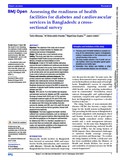| dc.contributor.author | Biswas, Tuhin | |
| dc.contributor.author | Haider, M Moinuddin | |
| dc.contributor.author | Gupta, Rajat Das | |
| dc.contributor.author | Uddin, Jasim | |
| dc.date.accessioned | 2022-03-13T04:48:47Z | |
| dc.date.available | 2022-03-13T04:48:47Z | |
| dc.date.copyright | 2018 | |
| dc.date.issued | 2018-10-31 | |
| dc.identifier.citation | Biswas, T., Haider, M. M., Das Gupta, R., & Uddin, J. (2018). Assessing the readiness of health facilities for diabetes and cardiovascular services in Bangladesh: A cross-sectional survey. BMJ Open, 8(10) doi:10.1136/bmjopen-2018-022817 | en_US |
| dc.identifier.uri | http://hdl.handle.net/10361/16444 | |
| dc.description | This article was published in the BMC Nephrology [© Author(s) (or their employer(s)) 2018. Re-use permitted under CC BY-NC. No commercial re-use. See rights and permissions. Published by BMJ.] and the definite version is available at: 10.1136/bmjopen-2018-022817 The Journal's website is at: https://bmjopen.bmj.com/content/8/10/e022817 | en_US |
| dc.description.abstract | Objective: The objective of this study was to assess the readiness of health facilities for diabetes and cardiovascular services in Bangladesh.
Design: This study was a cross-sectional survey.
Setting: This study used data from a nationwide Bangladesh Health Facility Survey conducted by the Ministry of Health and Social Welfare in 2014.
Participants: A total of 319 health facilities delivering services focused on diabetes and cardiovascular diseases (CVD) were included in the survey. Some of these facilities were run by the public sector while others were managed by the private sector and non-governmental organisations. It was a mix of primary and secondary care facilities.
Primary and secondary outcome measures: The primary outcome was readiness of health facilities for diabetes and cardiovascular services. We analysed relevant data following the Service Availability and Readiness Assessment manual of the WHO to assess the readiness of selected health facilities towards services for diabetes and CVD.
Results: 58% and 24.1% of the facilities had diagnosis and treatment services for diabetes and CVD, respectively. Shortage of trained staff (18.8% and 14.7%) and lack of adequate medicine supply (23.5% and 43.9%) were identified to be factors responsible for inadequate services for diabetes and CVD. Among the facilities that offer services for diabetes and CVD, only 0.4% and 0.9% had all the four service readiness factors (guideline, trained staff, equipment and medicine).
Conclusions: The study suggests that health facilities suffered from numerous drawbacks, such as shortage of trained staff and required medicine. Most importantly, they lack effective guidelines on the diagnosis and treatment for diabetes and CVD. It is, therefore, essential now to ensure that there are trained staff, adequate medicine supply, and appropriate guidelines on the diagnosis and treatment for diabetes and CVD in Bangladesh. | en_US |
| dc.language.iso | en_US | en_US |
| dc.publisher | BMJ Open | en_US |
| dc.relation.uri | https://bmjopen.bmj.com/content/8/10/e022817 | |
| dc.subject | Human resource management | en_US |
| dc.subject | Organisational development | en_US |
| dc.subject | Quality In health care | en_US |
| dc.title | Assessing the readiness of health facilities for diabetes and cardiovascular services in Bangladesh: A Cross-sectional survey | en_US |
| dc.type | Journal Article | en_US |
| dc.description.version | Published | |
| dc.contributor.department | Brac James P. Grant School of Public Health | |
| dc.identifier.doi | http://dx.doi.org/10.1136/bmjopen-2018-022817 | |

